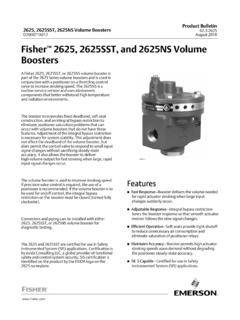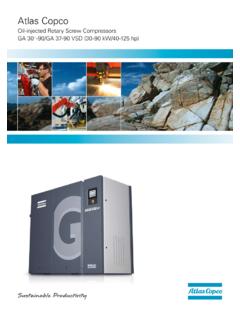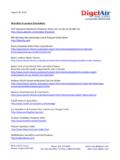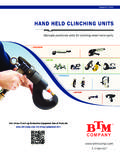Transcription of CPR Tech's Tip Book - Industrial Air Compressors
1 GENERAL TERMS CONTINUED DETERMINING YOUR. AIR REQUIREMENTS. PISTON DISPLACEMENT: Is the volume swept by the piston, generally expressed in cubic feet per A relatively simple procedure to see if additional compressor capacity minute (CFM). For multi-stage Compressors , the piston displacement (CFM) is required can be performed in any plant or compressed of the first stage only is commonly stated as that of the entire machine. air-using operation. Most general compressor air operations supply 100 PSIG at the ACTUAL CAPACITY: compressor and deliver a minimum of 90 PSIG to the using air tool.
2 For Is the quantity of gas actually compressed and delivered to the lowest possible power cost, this means compressor has a cut out discharge system by the compressor at rated speed and under rated pressure or unloads at 100 PSIG and cut-in or loads at 90 PSIG. receiver or system pressure. With these known figures (or whatever pressure conditions. Actual capacity is expressed in cubic feet per unload and load figures a particular system utilizes), we can determine minute at the temperature and pressure conditions existing at the inlet the following: to the first stage. If the receiver is below the normal cut-in point (90 PSIG) or does not gradually rise to the cut-out point (100 PSIG), more air is probably VOLUMETRIC EFFICIENCY: needed.
3 Always check, of course, that there are no significant leaks Is the ratio of actual capacity to piston displacement, generally stated and that the unloading and control system on the compressor are as percentage. functioning correctly. NOTE: If the compressor must operate at more than 100 PSIG to get FREE AIR: 90 PSIG at the tools, check the distribution system for piping size or Generally describes air at room or ambient temperatures and pressures, check points. The pipe may be too small or a single choke point too that is, normal atmospheric conditions. In other words, the term free air small for the system's total demand (flow) or length.
4 Describes the air actually taken into the suction of a compressor which takes air from the surrounding atmosphere. CHECKING EXISTING. COMPRESSOR CAPACITY. STANDARD CONDITIONS: Are not universally defined; therefore, since compressor capacities are Running a timed pump-up test is a relatively accurate way to check sometimes expressed in standard cubic feet per minute (SCFM), it is your existing air compressor's capacity or output. This will confirm that necessary to identify, before the compressor can be sized, (1) the your shortage of compressed air is not due to a worn unit or a standard pressure condition; (2) the standard temperature condition; malfunction.
5 (3) the compressor suction pressure condition, and; (4) the Check the receiver volume in cubic feet. Check the pipe volume compressor suction temperature condition. The most popular between the compressor and receiver in cubic feet. Operate the identification for standard pressure and temperature conditions is compressor at load. Close the air valve between the receiver and plant PSIA or 60 F.. air system. Drain the receiver down to 70 PSIG. Close the drain valve quickly. Record in seconds the required time to pump to 100 PSIG. BRAKE HORSEPOWER (bhp): Now work the following equation: Is the measured horsepower input at the compressor shaft.
6 The If this is close to the rated capacity of your air compressor, then you can horsepower output of the driver must equal or exceed the compressor be relatively sure the demand on your air system is too high and you bhp plus any drive losses. need additional air. C = COMPRESSOR CAPACITY IN CFM. LOAD FACTOR: Is the ratio of the available demand for compressed air during a certain V = RECEIVER & PIPING VOLUME IN CU. FT. period of time to the maximum rated output capacity of the compressor. P2 = FINAL CUT OUT PRESSURE PSIA. = 100 PSIG + = PSIA. NOTES: P1 = INITIAL PRESSURE PSIA. = 70 PSIG + = PSIA.
7 V (P2 - P1) 60 SEC. C = ( ) (TIME-SEC.). * Assume the receiver and piping volume were 80 cu. ft. * Assume the pump-up time is 15 seconds. Then solve: (80) ( - ) (60). C = ( ) (15). 144,000. C = C = 653 cubic = actual capacity of existing air compressor 28 1. TERMINOLOGY CONTINUED COMMON LEAK PROBLEM AREAS. UNLOAD (No Load): COUPLINGS, HOSES, TUBES AND FITTINGS. Air compressor continues to run (usually at FULL RPM), but NO air is Tubes and push-to-lock fittings are common problems. delivered because intake is either closed off or modified , NOT allow- ing inlet air to be trapped. DISCONNECTS.
8 O-rings required to complete the seal may be missing. MODULATING UNLOAD: FILTERS, REGULATORS AND LUBRICATORS (FRL's). Air compressor continues to run and air supply is matched to demand Low first-cost improperly installed FRL's often leak. by partial unloading . This is usually accomplished by a regulator controlled floating inlet . OPEN CONDENSATE TRAPS. Improperly operating solenoids and dirty seals are often problem START-STOP CONTROL: areas. Air supply is matched to demand by actual starting and stopping of the unit. PIPE JOINTS. Missed welds are a common problem. CUT-IN/CUT-OUT PRESSURE: CONTROL AND SHUT-OFF VALVES.
9 The settings on a pressure switch used to either load or unload the air Worn packing through the stem can cause leaks. compressor on constant speed application. The cut-out pressure is also referred to as maximum pressure , the point at which there is NO POINT OF USE DEVICES. AIR DELIVERED. The cut-in pressure is also referred as Old or poorly maintained tools can have internal leaks. minimum pressure - the pressure that the system is allowed to fall to FLANGES. before additional air volume is called for. The compressor runs at full Missed welds are a common problem. load between cut-in and cut-out.
10 CYLINDER ROD PACKING. VARIABLE DISPLACEMENT CONTROLS: Worn packing materials can cause leaks. Also called Rotor Length Adjustment in oil cooled Rotary Screw controls. Particularly efficient in holding constant speed from 60% to THREAD SEALANTS. 100% capacity variable speed control. Below this usually goes to blow Incorrect and/or improperly applied thread sealants cause leaks. down and idle. HOW DO YOU FIND LEAKS? VARIABLE SPEED CONTROL: Most commonly applied in oil cooled Rotary Screws. Very efficient from Since air leaks are almost impossible to see, other methods must be about 50% to 100% capacity.






